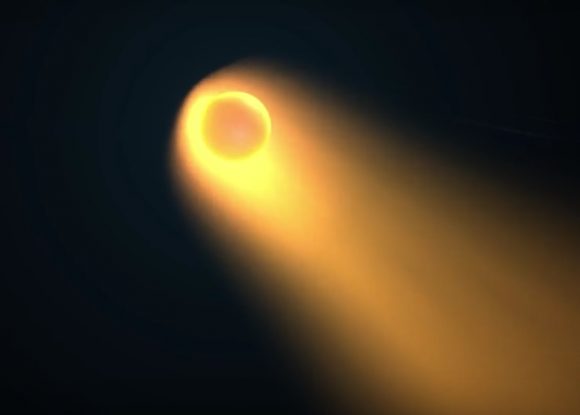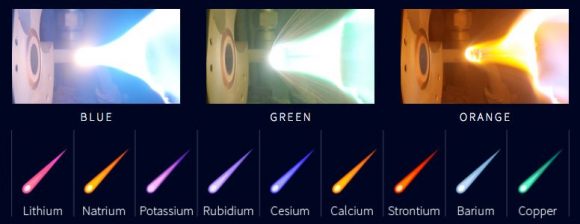A company named Sky Canvas plans to launch a colorful artificial meteor shower barrage via micro-satellite.
In the 'strange but true department' and a plan that would make any super-villain envious, a Japanese start-up plans to shoot meteoroids at the Earth to create the first orchestrated artificial meteor shower. The effort is benign in a bid to study the behavior of meteors and reentry characteristics, while also putting on a good show.
The idea is brainchild of Lena Okajima, who started the ALE Company which is funding the project.
"I'm very excited about this project, not only because it will turn my childhood dream into a reality, but also because it can contribute to fundamental scientific research in a new form without relying on public funds and donations," Okajima said on her biography on the ALE website.
First, a clarification: despite what several news sites have reported, Sky Canvas/ALE have not made a formal bid to incorporate the proposal as part of the 2020 Olympics in Japan, though they're certainly open to the idea. An artificial meteor shower during the opening ceremonies for the 2020 Olympics in Japan would definitely be a unique first!

A meteor shower-dispensing satellite in low Earth Orbit. Image credit: Sky Canvas.
Early testing and a first satellite launch with an as-yet unannounced carrier may occur in the later half of 2017, with another launch per year, each year following.
Long a dream of astronomer Lena Okajima, an artificial meteor shower may soon grace a sky near you.

A ball-bearing sized artificial meteor on reentry. Image credit: Sky Canvas.
Visibility Prospects
The meteoric payload will be carried into low Earth orbit aboard a small 50x 50x 50 centimetre cubical satellite dispenser. Different pellets will burn blue, orange and green. The team won't reveal the 'secret formula' for the colors, but you only have to think back to high school chemistry class and Bunsen Burner flame tests to imagine the elements probably used. (hint: the green isn't kryptonite). Laboratory tests suggest that the artificial meteors should be visible from about 200 kilometers (120 miles) away. Said satellite dispenser will carry about a 300-500 pellets. At say, a meteor a second, such a display would last from five to just over eight minutes in duration.

A rainbow of elemental colors. Image credit: Sky Canvas.
A test carried out in the lab verified that the brightness for the pellets should be right around apparent magnitude -0.86, just a bit fainter than the brightest star in the sky Sirius at magnitude -1.5.
Looking for an artificial meteor shower to light up your next event? Well, such a performance isn't cheap. With a roughly eight million dollar price tag, an artificial meteor shower breaks down to about $16,000 USD per meteor.
The plan is to place the 50 kilogram satellite (fully loaded) in a sun-synchronous orbit. This is a highly inclined retrograde polar orbit, also favored by Earth-observing and (supervillians take note) spy satellites.

The visibility prospects for Sky Canvas over a major urban area. Image credit: Sky Canvas.
The Sky Canvas system will also have the ability to 'weather abort' about 100 minutes prior to the event in case of inclement weather. Once in low Earth orbit, said satellite will orbit the planet once every 90 minutes. Such a dispenser is a one shot affair, and will burn up shortly after use.
Are artificial meteor showers a great idea? On one hand, it might be a great educational resource, and a way to get the general public excited about space and astronomy. Still, for those of us who have endured many an early morning vigil for the occasional surprise flash of a meteor, there's perhaps something a bit kitschy about meteor showers on demand. It's also slightly reminiscent of the early Space Age ideas to create nighttime illumination via large mirrors floating in space, or place advertising (!) in low Earth orbit. Streaks of artificial satellites already routinely photobomb deep sky images... do we want to contend with orbiting Pepsi logos as well?
Some may also bemoan the advent of yet more artificial light – however ephemeral -- streaking across the already brightening sky. And here's another possible dilemma: will a -1 magnitude artificial meteor appear all that impressive from the already garish glare of downtown Tokyo, Las Vegas or Dubai? Still, I'd make the trip to see the world's first artificial meteor shower... and humanity already routinely creates similar unheralded "shows" every time a piece of space junk reenters the Earth's atmosphere.
I also can't help but think of the fictional metal band Disaster Area from Douglas Adams' Hitchhiker's Guide to the Galaxy, which ended each concert with a sun-diving spaceship.
There are also possible practical applications for the project, including understanding meteor showers, spacecraft reentry, studying the upper atmosphere, etc. And though this may seem far-fetched, NASA already uses luminous chemicals dispersed from sounding rockets to do the same thing.
JAXA has already performed similar artificial meteor experiments here on Earth using an arc-heated wind tunnel laboratory, mimicking and modeling the Chelyabinsk meteor and the asteroid sample return mission Hayabusa-1 and the return future return of Hayabusa-2.
Just maybe though, light pollution awareness might prove to be the project's greatest strength. An artificial meteor shower might just cause city dwellers and urban planners to turn the lights down, and simply gaze up at the night sky for a brief moment.








No comments:
Post a Comment